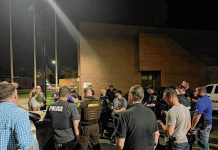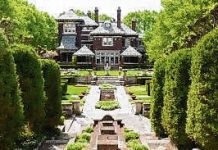
A group of graduate students and a professor from Indiana University’s J. Irwin Miller Architecture Program is inviting local residents to play along and have a little fun with light as they pass by the former Republic building in downtown Columbus.
A new, interactive installation, “Lines of Light,” is now installed along the glass panels of the building facing Second Street downtown, and will be open for the public to experience through April, said assistant professor of architecture Daniel Martinez.
The installation uses motion sensors on the building’s steel columns to activate a row of lights, which are more easily observed at night. Visitors can walk up to the outside of the building on its north side and use these sensors as part of a socially-distanced game.
Martinez compared it to “playing catch with light.”
“The sensor is located lower on the column,” he explained. “So essentially, if you make the motion as if you were kicking a ball or maybe rolling a ball like you were bowling in a bowling alley, it triggers the sensor within a certain distance of the glass facade, and that sends the lights in succession towards your opponent or your friends on the other side, where there’s another sensor located. And they can then send the light back to you.”
The installation is best seen after sunset — in the dark. He also noted that the lights are sometimes triggered by passing cars because of the vehicles’ reflections on the glass.
The core group of students involved in the project were Shorf Afza, Jacquelyn Brice, Alyssa Bullock and Mark Kebasso.
“I was really proud of the intensity and the work that the students put in, especially during the summer when they would normally be interning or getting some rest,” Martinez said. “… Graduate school and architecture’s pretty intense.”
DJ Brock was also part of the group and was heavily involved in coding and programming for the project. Brock’s wife is a student in the architecture program. The group is also working with the creative group Echo Bravo to produce a video of the installation to be shared online.
Martinez and his students were awarded a grant for the installation from the Columbus Museum of Art & Design. According to CMAD’s website, the grant was for $750, plus an additional $100 stipend for marketing. It was administered in partnership the Columbus Area Arts Council.
Martinez said that the lighting was a donation from ESL Spectrum, a lighting group based in Indianapolis.
The project’s roots stem back to “Architectural Lighting: Techniques + Poetics,” an elective seminar taught by Martinez in spring of 2020.
“That was a really interesting class that, I think, sparked a conversation among students and an interest in wanting to work with light more intensely,” he said. “… I think it created kind of a thirst to see if we could test out some stuff at full-scale.”
After the class had ended, a few of Martinez’s students contacted him about their interest in working on a new project and possibly pursuing some grants in the process. So he presented a challenge: what could the group do with 30 meters of LED linear lights that were leftover from a previous exposition?
“I said, ‘We have these lights. I would love to repurpose them in a really poetic way. So your challenge is to incorporate it into a lighting installation,’” Martinez said.
Together, he and the students developed the concept, applied for the grant and worked on testing and installation. Martinez was also involved in additional project management.
The group met on a weekly basis throughout the summer. Martinez said they spent time thinking about how to call attention to the building’s “lines of structure” while also highlighting the lawn that surrounds the building.
“The installation merged or evolved to become a game,” he said. “And a part of this was also thinking that during the pandemic, with people quarantined, that this could be a opportunity to create something that might actually just be a safe game, right? Specifically distanced enough that people could play this and enjoy it outside.”
The project also provided a unique experience for students amid the challenges of COVID-19.
The pandemic “forced us to think and create in a different way than normal, said third-year student Mark Kebasso, who worked on the project. At times, the work took place virtually; at others, it was in-person.
“We found that the times that we met in a socially distant manner and worked on the setting up of the project at the Republic were sentimental, and the exchange of ideas was robust, as some of us had not been around people as such since the pandemic shutdowns,” he said. “Goes to show that design and architecture are purely social fields and thrive in settings where there is in-person engagement.”
Martinez said that the installation is a good example of the same type of interdisciplinary creativity found in Landscape, Art & Architecture, a design studio he co-founded.
“That idea of landscape, art and architecture is something we try to carry through all of our work, everything that we’re involved in,” he said. “… We find that it’s in these spaces between disciplines that really interesting things happen. So the idea that you could activate a landscape, for instance, using a work of architecture through public art — that’s the kind of interwoven opportunity that we seek out often.”
While the project stemmed from the university, it’s also the kind of work that “feeds our creativity in the (LAA) studio,” he said.
When asked what he hopes the project provides to the community, he replied, “Joy and laughter, honestly, above all else, that it can be a place where you just discover something fun and cool that’s participatory in the form of public arts.”
[sc:pullout-title pullout-title=”Where to play” ][sc:pullout-text-begin]
The Lines of Light installation can be found on the north side of the former Republic building, which faces Second Street. The building, located at 333 Second St., houses Indiana University’s J. Irwin Miller Architecture Program.
The installation will continue through April and is best seen after sunset.
[sc:pullout-text-end]




